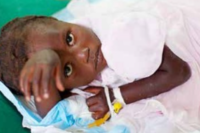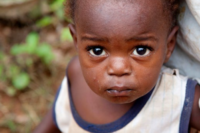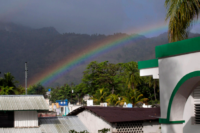By Jeff Rhode. Media Specialist, Holy Name Medical Center
Photographing people in a foreign country presents many unique challenges that can be confusing to a photographer. There can be language barriers, unfamiliar customs, anxiety and physical demands that are not encountered at home. Haiti presents a photographer with all of these challenges.
The Assignment
My assignment in Milot, Haiti was to document and show what Holy Name Medical Center is doing to help The CRUDEM Foundation and Hôpital Sacré Coeur. The images and video I made would be used to raise awareness of the severe and extreme circumstances that the people in this rural part of Haiti endure, and show why Holy Name became involved in this mission. It was easy to walk through the hospital and photograph improvements that are needed and ones that were made, but I felt that more of a connection would be gained learning about the people of Milot and the villages that surround Hôpital Sacré Coeur.
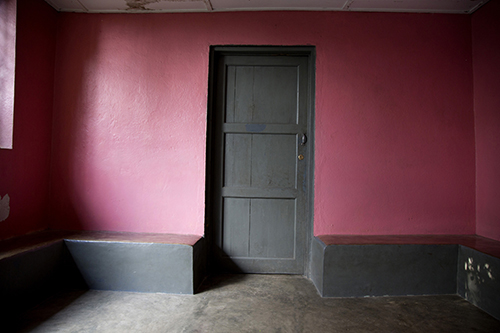 The Communication Challenge
The Communication Challenge
On my first trip to Milot, my initial challenge was finding a way to communicate with the people and stay safe. I tried a couple of recommended translators who know the area and spoke fluent English and Creole. But, I was not successful finding the places I was looking for to capture and connect with the residents of Milot. One morning when I was leaving the CRUDEM campus there was a man at the gate who spoke a little English and offered to take me to his house to photograph his family. Whether I wanted him to take me or not, he was walking along with me and talking.
I learned that his name is Dennis and he has lived in Milot his whole life. He has hundreds of relatives throughout the community and as we walked down the dirt road greetings were yelled to him from every direction. It became clear that he was the man that could lead me to becoming less of a tourist. His English isn’t perfect, and he doesn’t always understand what I ask for right away. But for 6 days, on every trip, he is my lifeline when I walk through the jungle to get to villages, look for children doing school work, or find a stream where women gather to do laundry. Finding someone local who could help me was the largest hurdle I overcame.
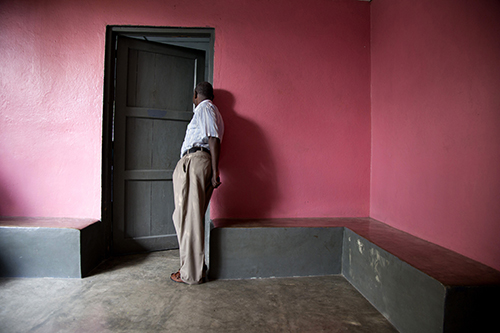 The Anxiety Challenge
The Anxiety Challenge
Traveling internationally and interacting with strangers is stressful to me. Initially, I have to bring myself to interact. Once I do it a few times, I relax and start to become comfortable, and from that point forward things flow. The quicker you can get through the anxiety and start focusing on what’s in front of you, the better.
What to Look For
After becoming comfortable, I look for anything that has emotion, or is a “moment” that may normally pass us by. This can come in the form of a gesture, an expression, body language, or composition and light. It is really helpful to try and predict what may happen next in any situation, which will tell you where the action is going, or if there will be a change that will elicit a “moment”.
With the photo of the pink wall, I saw it, took a couple of shots to confirm exposure, and then waited. I had seen one person enter the door and saw the shadow. The next person knocked on the door and stuck his head in, and he got this interesting curve to his body, which was accentuated by his shadow.
 Stay Alert
Stay Alert
I was in a meeting taking public relations type photos and was standing next to a window and heard the rain outside. I pulled the curtain and looked out and saw the most vibrant rainbow I have ever seen stretching across the mountain and hospital grounds. I knew the meeting wasn’t going anywhere and I would be able to return to it, so I headed out and managed to take 6 frames and it just disappeared.
I was lucky to see it — but if I had waited there wouldn’t be any photo.
 Be Ready to Change Direction
Be Ready to Change Direction
Opportunities can come and go very quickly and I try to always be prepared to react. Not so long ago, while photographing a shipping container being unloaded for the hospital, I was kneeling on the ground to get a low shot with a wide lens. After taking the shot I turned and noticed a girl and boy walking from school holding hands. I got 1 shot and they were gone. This was one of those “moments” I was describing.
If you are planning a trip to Milot and have specific photography questions, please feel free to contact me at Rhode@holyname.org
Jeff’s Equipment List
This is the bulk of what I bring to shoot photo and video on the road in Milot. Everyone will have a preference and need for different equipment. This is my list based upon what I need and what I have available to use.
| • 1 Canon 5D Mk II body • 1 Canon 5D Mk III body • Canon 16-35 F2.8 • Canon 24-70 F4 • Canon 70-200 F2.8 • Canon 1.4 teleconverter • 2 Canon 430 flashes |
• Sennheiser MKE-400 mic • Sennheiser Evolution wireless mics • Juiced Link DT454 pre amp for sound • Skull Candy ear buds • Manfrotto fluid head tripod • Small HD external video monitor • Red Rock Micro handles and rails |
• 4 Extra batteries and 6 32GB CF cards • 1-2 each extra of any cable I use • Formatt multistop neutral density filter • CF Card reader • Apple Macbook Pro • External hard drive to back up the day’s work • Backpack style bag to bring what I need when hiking |
I hope this list helps you when photographing in Milot, or anywhere else. If you are planning a trip to Milot and have specific photography questions, please feel free to contact me at Rhode@holyname.org
Technical Tips for Photographing in Milot, Haiti
By Jeff Rhode
When first going to Haiti to photograph, there were several technical challenges along the way. Some I was prepared for and others were unexpected. I hope this list of tips helps you on your journey through Milot!
It’s bright!
Milot is closer to the equator than the USA, so I did not anticipate how much brighter the sun would be. It is not a perceptible difference, but to a light meter in a camera it is at least twice as bright (1-2 stops)! It is not nearly as much an issue with digital photography as with film, because “ISO” can be adjusted on the fly. Always use the lowest ISO possible for a cleaner image. An ND filter is a great way to reduce the amount of light entering the lens so you can shoot wide open too.
Shoot RAW.
All DSLR cameras are capable of shooting JPEG compressed files, and RAW files. Each has advantages and disadvantages. Two advantages of a JPEG is that the file is compressed, taking up a small chunk of your memory card, and they can also be used right out of the camera. The RAW files are not compressed, which can take a huge amount of space and need to be processed on a computer before saving them to any other popular format (Tiff, JPEG, Photoshop), which is time consuming. This is where the disadvantages end though. Setting your camera to RAW will allow you to make adjustments to the file on your computer as if you were making them in the camera during the exposure. Things like color balance, exposure, contrast, and recovering highlights can all be adjusted at this stage, saving valuable detail and allowing the best possible reproduction. I have even opened up the same image once with the highlights properly adjusted, and again with shadows properly adjusted, and combined the two for detail in highlight and shadow. Memory cards are not that expensive, so buy extras and shoot RAW.
Adjust for skin tones.
Shooting RAW will help you recover any shadow detail lost, but I will often choose to overexpose 1/3-2/3 stops to help retain detail in dark areas of a photo, especially with a darker complexion.
Know your camera.
It is very frustrating to get on a location and not be able to take the photo that you want due to not knowing why something is going wrong with exposure or focus. Practice using your camera before your trip and review the photos on a computer. It’s is a great way to become familiar with the camera functions, spot a technical issue, and figure out why it happened and how to correct it. Once comfortable, you will also stop thinking about operating the camera and think more about the images.
Rent it.
If you are traveling on a short trip and wish you had a longer, wider, or faster lens that you normally would use, rent it for your trip. You will be surprised how little it costs to rent a professional lens or camera for a week or two. I use borrowlenses.com for equipment rentals.
Get Consent!
Photos on hospital grounds require the express approval of Dr. Prévil and the written consent of the subject.






